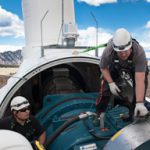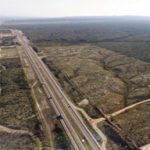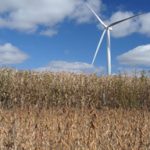The Buffalo Bill Center of the West received a $50,000 grant from Duke Energy Foundation in support of Monarch of the Skies, an exhibition about golden eagles and their habitats. The project presents the natural and cultural history of the golden eagle and its conservation in Greater Yellowstone and western United States.
The exhibition is slated to open in spring 2018.
Charles R. Preston, wildlife scientist and the center’s Willis McDonald IV senior curator of the Draper Natural History Museum, leads the design effort.
“This exhibition provides a wonderful opportunity to share the adventure, results, and application of scientific research by our own team and by others across the western United States,” Preston said. “And we are delighted to receive this support from Duke Energy, an important stakeholder and contributor to golden eagle conservation for the future.”
“Golden eagles thrive in some of the windiest places in the country, which include the open plains of Wyoming,” said Tim Hayes, Duke Energy Renewables environmental director. “This same abundant wind resource can be tapped to make clean and increasingly affordable electricity, but this overlap sometimes creates a conflict between golden eagle habitat and wind farms. Our primary focus for several years has been figuring out a way for wind turbines and eagles to coexist.”
Based on a decade of extensive field research conducted by the Center’s Draper Natural History Museum, the eagle exhibition immerses visitors in the power, beauty, and cultural and ecological significance of North America’s most powerful raptor. The exhibition integrates interpretive text, graphic panels, and audiovisual components with interactive features. In addition, the project’s plan includes stunning photographs, a reproduced sandstone cliff nest site, three-dimensional models, mounted specimens, and Plains Indian ethnographic objects.
Golden eagle strongholds in sagebrush grasslands are undergoing rapid changes, and scientists are concerned about the impacts on eagles and associated wildlife. The “Challenges and Opportunities” section of the exhibition is designed to focus on the human-caused threats to golden eagles and associated wildlife, and the efforts of multiple stakeholders to reduce and mitigate negative impacts. One challenge golden eagles face in today’s West is increased mortality due to collisions with the growing numbers of wind turbines.
“At Duke Energy Renewables’ wind sites, we are continually refining ways to reduce the risk of golden eagles and other soaring raptors from colliding with wind turbines,” Hayes said. “Our Top of the World wind site near Glenrock, Wyoming, has tested radar, visual and sound deterrents and is currently using a camera detection system called IdentiFlight as well as human observers to curtail turbines when eagles are present, thereby reducing collisions.”
The exhibition showcases these and a broad range of other efforts underway to ensure that the golden eagle remains a vital component of western ecosystems and America’s natural heritage.
“These magnificent raptors are a true apex predator and have never had to worry about something harming them while they are flying,” Hayes said. “We have more work to do, but through partnerships with scientists like Dr. Preston, technology developers like IdentiFlight, and organizations like the American Wind Wildlife Institute, I’m confident we will find viable solutions.”
Source: Duke Energy Renewables
For more information, go to www.duke-energy.com/renewables



































